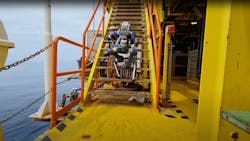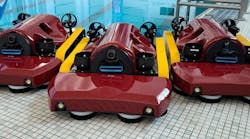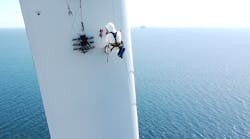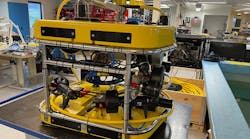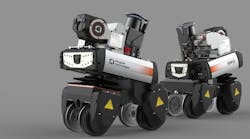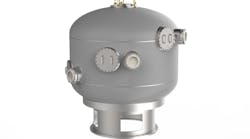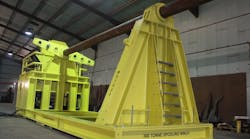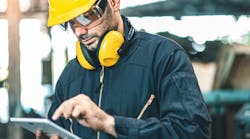Editor's note: This story first appeared in the May-June 2023 issue of Offshore magazine as part of the Remote Inspections & Operations Special Report.
By Dr. Marco Hutter, ETH Zurich and ANYbotics; and Dr. Péter Fankhauser, ANYbotics
Advanced robotic technology is revolutionizing offshore facility inspections, making them safer, more efficient and cost-effective. This article delves into the capabilities of autonomous inspection robots, their impact on the oil and gas industry, and their potential to transform offshore asset monitoring as well as reviews various types of robots and the future prospects of fully autonomous, unmanned offshore facilities operated by robotic workers.
Automating offshore facility inspections
The wide variety of offshore oil and gas platforms, such as fixed platforms, compliant tower platforms, jackup platforms and floating production systems, share common operational challenges arising from potentially explosive atmospheres, complex infrastructure, extreme weather conditions and remote locations.
Operators constantly seek real-time data from their assets to monitor asset health and take timely preventive action. Today fixed installed sensors already monitor critical process aspects like temperature, pressure and flow rates. Additionally, operators perform regular inspection rounds, typically within each work shift, to look for signs of damage or wear on equipment. However, the logistical challenges and expenses of accessing offshore platforms, as well as the importance of personnel safety, complicate these inspections.
To mitigate safety risks and collect better data than manual inspections, oil and gas companies are increasingly adopting autonomous ground robots for routine inspection work. The latest generation of autonomous inspection robots can traverse oil and gas facilities designed for humans and collect data in complex environments without human intervention.
Inspection robots automating jobs
Autonomous inspection robots provide significant value to offshore operations by performing inspection tasks autonomously, delivering frequent, accurate and reliable results. High-quality sensors, extreme mobility and AI-based inspection intelligence allow these robots to perceive and analyze beyond human capabilities and be easily deployed, even in older brownfield facilities. Inspection robots perform continuous monitoring with hundreds of inspection points per deployment and execute multiple precise tasks simultaneously. Inspections can be scheduled as routine, relevance-based monitoring, or on-demand, conditional or ad hoc inspections.
Specific offshore inspection jobs automated by these robots include:
- Visual and acoustic monitoring of assets in operation to detect equipment failures early and take preventive maintenance actions to avoid costly defects and downtime;
- Identifying thermal anomalies to gain previously undetected insights into equipment health through thermal trend analyses; and
- Real-time monitoring and localization of the presence and concentration of flammable and toxic gasses to enable early operator action.
These capabilities allow inspection robots to support and complement humans in generating alerts, making critical decisions, responding early to detected anomalies and automating end-to-end workflows and preventive maintenance.
Challenging offshore inspections
Offshore inspections are challenging for both robots and humans due to complex terrain, corrosive atmospheres, high winds, high seas, and potentially dangerous or unpredictable situations. Areas handling flammable or explosive gasses or liquids are Ex-rated, requiring Ex-certified, intrinsically safe equipment, such as ATEX or IECEx certification. These areas include zones (Zone 0, Zone 1 or Zone 2) depending on the occurrence and duration of explosive atmospheres. Zone 1 certification is necessary to bring inspection robots close to process areas where they provide the greatest value. While the industry has developed standards for heavy machinery, it remains challenging for agile robots to comply.
Several robots on the market are certified for use in hazardous environments, but their capabilities vary depending on their locomotion mechanisms. Robots with wheels or tracks, such as the ExR-2 from ExRobotics, are well-suited for flat terrain but may struggle in more complex environments. Some tracked systems, like the Inspector from Taurob and EX ROVR from Mitsubishi Heavy Industries, are equipped with "flippers" that allow them to traverse more complex terrain, including high steps.
However, larger robots may have difficulty navigating narrow environments. To address this, some robots, such as the ANYmal X from ANYbotics, use legs to provide maximum flexibility. These robots can negotiate steep stairs, step over piping and navigate narrow environments due to their ability to move sideways. When selecting a robot, it is important to consider the specific needs of the application, as the choice of locomotion mechanism can significantly impact its performance in different environments.
Transforming offshore asset monitoring
The oil and gas industry is a hotbed of innovation driven by the need for efficient production, safety, cost control and improving the long-term sustainability of operations. Technological advances in autonomy, mobility and inspection intelligence have made inspection robots increasingly attractive for offshore use.
Operators such as Shell, Petronas and bp have been working with robots for several years, and the adoption of Ex-proof inspection robots has recently gained momentum among many offshore operators. Autonomous, legged Ex-proof inspection robots are transforming offshore monitoring, with operators increasingly incorporating these robotic solutions into their inspection and workforce planning.
Autonomous inspection robots not only reduce health and safety risks but also help mitigate an increasing workforce shortage, one of the main reasons for the accelerated adoption of robotic solutions. Additionally, operators benefit from reduced manual labor, fewer people in hazardous environments and decreased unplanned downtimes. Autonomous inspection robots contribute to safer, greener and more efficient offshore operations.
Future development
The use of autonomous mobile inspection robots represents a paradigm shift and fundamentally changes the perception of the constant need for the physical presence of human workers. As a result, fleets of robotic workers will increasingly be remotely managed by human supervisors. The accelerated use of inspection robots in the offshore oil and gas industry is a positive trend expected to continue in the coming years. With the continued development of AI-driven capabilities, robots are a key enabler in the acceleration of digitization and automation.
In addition to inspection, robotic manipulation is a rapidly evolving field involving the development of robots that can manipulate objects. In the oil and gas industry, manipulation will allow robots to handle equipment, take samples and perform simple maintenance tasks.
The concept of unmanned offshore oil and gas facilities specifically built with robots in mind has gained traction in recent years, and interest in developing such facilities is growing. These facilities would be operated entirely by autonomous systems and robots, requiring little or no human intervention and reducing overhead in living quarters, HVAC, desalination and safety requirements. The potential benefits of safety, efficiency and cost reduction make this concept a promising area for future development.
